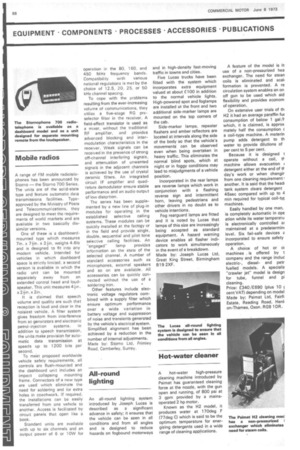Mobile radios
Page 90

If you've noticed an error in this article please click here to report it so we can fix it.
A range of FM mobile radiotelephones has been announced by Storno — the Stoma 700 Series. The units are of the solid-state type and feature automatic data transmissions facilities. Typeapproved by the Ministry of Posts and Telecommunications, they are designed to meet the requirements of world markets and are available in two basically dissimilar versions.
One of these is a dashboardmounted type which measures 7in. x 7iin, x 2-fin, weighs 4.6Ih and is designed to fit into any modern vehicle. Intended for vehicles in which dashboard space is strictly limited, a second version is available in which the radio unit can be mounted
separately away from an extended control head and loudspeaker. This unit measures 4in. x 2}fin.x 2in.
It is claimed that speech volume and quality are such that reception is loud and clear in the noisiest vehicle. A filter system gives freedom from interference from ac generators and electronic petrol-injection systems. In addition to speech transmission, the units make provision for automatic data transmission at speeds up to 1200 bits per second.
To meet proposed worldwide vehicle safety requirements, all controls are flush-mounted and the dashboard unit includes an impact collapsing mounting frame. Connectors of a new type are used which eliminate the need for soldering and for extra holes in coachwork. If required, the installations can be easily transferred from one vehicle to another. Access is facilitated by circuit panels that open like a book.
Standard units are available with up to six channels and an output power of 6 or 10W for operation in the 80, 160, and 450 MHz frequency bands.
Compatibility with various national regulations is met by the choice of 12.5, 20, 25, or 50 kHz channel spacing.
To cope with the problems resulting from the ever-increasing volume of communications, they utilize a five-stage RG preselector filter in the receiver. A field-effect transistor is used as a mixer, without the traditional RF amplifier, and provides advanced blocking and intermodulation characteristics in the receiver. Weak signals can be received in the presence of strong off-channel interfering signals, and attenuation of unwanted signals in the adjacent channels is achieved by the use of crystal ceramic filters. An integrated circuit IF amplifier and quadrature demodulator ensure stable performance and an audio output of low distortion.
The series has been supplemented by a new line of plug-in modules for operating in the established selective calling systems. These modules can be quickly installed at the factory or in the field and provide single, double, sequential and pilot tone selective calling facilities. An "engaged" lamp provides information on the state of the selected channel. A number of standard accessories such as microphones, external speakers and so on are available. All accessories can be quickly connected without the use of a soldering iron. • Other features include electronic voltage regulators combined with a supply filter which ensure optimum performance over a wide variation in battery voltage and suppression of noise and transients generated by the vehicle's electrical system. Simplified alignment has been achieved by a reduction in the number of internal adjustments. Made by: Stoma Ltd, Frimley Road, Camberley, Surrey.












































































































































